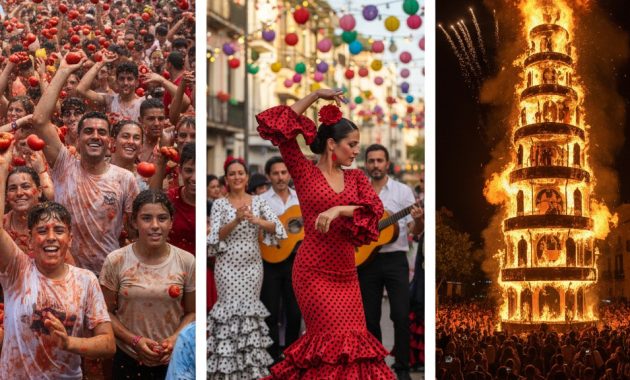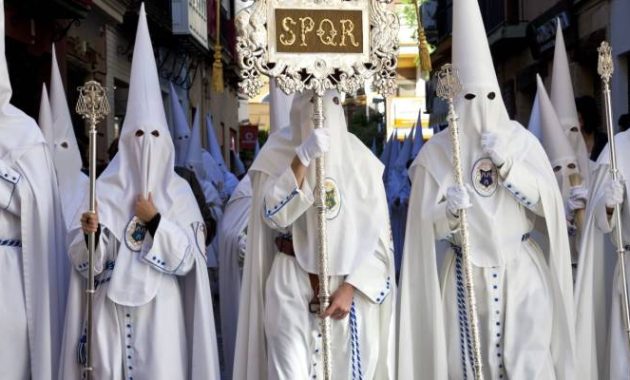
When Spain Comes Alive
If there’s one thing Spain does better than anyone, it’s knowing how to celebrate. Every corner of the country has its own festival — some grand and fiery, others sacred and deeply emotional. One day you might be dancing beneath a shower of red tomatoes; the next, you’re following candlelit processions through ancient streets. In Spain, festivals are not just events — they’re living expressions of history, faith, and pure passion. Whether it’s music echoing from the hills of Andalusia or fireworks bursting over the Mediterranean, each celebration tells you something about the Spanish soul: proud, joyful, and full of life. Let’s travel through the country’s calendar and discover the most unforgettable Spanish festivals and cultural events you can experience.
La Tomatina – Buñol’s Legendary Tomato Fight

Welcome to one of the world’s wildest food fights!
Every August, the small town of Buñol near Valencia turns into a sea of red as thousands gather for La Tomatina — an hour-long tomato-throwing frenzy.
What began as a local prank in 1945 has become an international sensation. Streets run with tomato juice, laughter fills the air, and no one leaves clean.
Traveler’s Tip: Wear old clothes, protect your eyes, and remember — squish before you throw!
Semana Santa – Holy Week Across Spain

In contrast to the chaos of La Tomatina, Semana Santa (Holy Week) is Spain’s most solemn and spiritual festival.
From Seville to Malaga, Granada, and Valladolid, the streets fill with processions of hooded penitents, candlelight, and slow, mournful music.
Each city offers a unique interpretation — Seville’s is grand and theatrical, while Zamora’s is hushed and haunting.
Even if you’re not religious, the emotion and artistry of Semana Santa will move you deeply.
Feria de Abril – Seville’s Spring Fair

Just two weeks after Semana Santa, Seville bursts into pure joy with the Feria de Abril.
Imagine women twirling in flamenco dresses, horse-drawn carriages parading through the streets, and tents (casetas) filled with dancing, laughter, and flowing rebujito (a local sherry cocktail).
This weeklong celebration of Andalusian culture is a feast for the senses — the colors, music, and warmth of the locals will sweep you off your feet.
San Fermín – The Running of the Bulls in Pamplona

Few festivals are as famous (or infamous) as San Fermín, held every July in Pamplona.
At dawn, brave runners dash through the streets ahead of charging bulls, cheered on by crowds of white-clad spectators waving red scarves.
While the run itself lasts mere minutes, the festival continues for days with parades, music, and fireworks — a thrilling mix of danger, tradition, and fiesta.
Traveler’s Tip: You don’t need to run to experience the excitement. Watching from balconies or barricades is just as exhilarating (and much safer!).
Las Fallas – Valencia’s Fiery Art Show

Every March, Valencia lights up — quite literally — for Las Fallas, a festival that fuses art, satire, and spectacular fire.
Giant papier-mâché sculptures called ninots fill the streets, often depicting celebrities, politicians, or pop culture scenes. On the final night, they’re all set ablaze during La Cremà — a fiery goodbye that symbolizes rebirth and renewal.
The scent of smoke, sound of fireworks, and spirit of creation make Las Fallas one of Spain’s most unique events.
Carnival – Spain’s Pre-Lent Party

Before the solemnity of Lent, Spain erupts in glitter and laughter during Carnival.
Tenerife hosts the most famous celebration — second only to Rio’s — with extravagant costumes, samba-inspired parades, and street parties that last all night.
Cádiz adds a satirical twist, with witty musical groups (chirigotas) performing clever songs that poke fun at politics and daily life.
Carnival is Spain’s joyful rebellion — a time to dress up, let go, and dance till dawn.
La Mercè – Barcelona’s Festival of Giants

In late September, Barcelona celebrates its patron saint, La Mercè, with fireworks, concerts, and towering gegants (giant paper-mâché figures) parading through the streets.
You’ll see human towers (castells) built by daring locals, traditional dances, and a thrilling correfoc — where fire-breathing devils race through the crowds.
It’s a festival that perfectly captures Catalonia’s creativity and community spirit.
San Sebastián Day – A Drum Parade of Pride
On January 20, the elegant city of San Sebastián wakes to the rhythm of thousands of drums.
During Tamborrada, locals dress as soldiers and cooks, marching through the old town, beating drums in honor of their city’s resilience and heritage.
It’s both patriotic and playful — the sound fills every corner, echoing the Basque people’s proud spirit.
Cordoba Patio Festival – A Blooming Competition
In May, the quiet courtyards of Córdoba open their doors to the public during the Festival de los Patios.
Residents compete to create the most beautiful flower-filled patios, draped in geraniums and jasmine, with fountains bubbling softly in the middle.
It’s an explosion of color and fragrance, and an intimate glimpse into Andalusian life.
Don’t miss: The Patio Route lets you wander from one private home to another — each a hidden paradise.
La Rioja Wine Harvest Festival – A Toast to Autumn
In September, Logroño, the capital of La Rioja, celebrates the grape harvest with wine tastings, parades, and — of course — a traditional grape-stomping ceremony.
Locals fill the streets in red scarves, toasting the new season’s wines with laughter and music.
It’s a must for any wine lover — a celebration that brings together Spain’s countryside charm and love for good company.
Christmas and New Year in Spain
Spain sparkles during the holidays.
From the Christmas markets of Madrid to the Three Kings’ Parade on January 6, festive cheer fills the air. Instead of champagne, locals toast the New Year with Cava, eating 12 grapes at midnight for good luck — one for each chime of the clock.
The warmth, lights, and family gatherings make this one of the most heartwarming times to visit.
Other Regional Highlights
- Moors and Christians Festival (Alicante & Valencia): Reenactments of medieval battles with grand costumes.
- Fiesta de San Isidro (Madrid): Honoring Madrid’s patron saint with music, bullfights, and traditional attire.
- Sónar (Barcelona): Europe’s top electronic music festival — a must for EDM lovers.
- Primavera Sound (Barcelona): Indie music heaven by the sea.
Spain never stops celebrating — from village fiestas to world-class festivals, there’s always a reason to dance, sing, and smile.
FAQs About Spanish Festivals
When is the best time to visit Spain for festivals?
Spring and summer offer the most vibrant events, from Las Fallas to Feria de Abril.
Are Spanish festivals free to attend?
Most are free, though some major parades or concerts may have ticketed sections.
Is La Tomatina safe?
Yes, but follow the rules — wear goggles, don’t throw hard objects, and respect others.
What should I wear to Feria de Abril?
Women wear flamenco dresses; men often dress smartly in suits or traditional Andalusian attire.
Can tourists join Semana Santa processions?
No, but you can watch respectfully from designated areas.
How long does San Fermín last?
Eight days, from July 6–14.
Are there food festivals in Spain?
Yes — from Galicia’s seafood festivals to Valencia’s paella fairs.
Spanish Festivals : Do I need tickets for La Mercè?
Most events are free; just arrive early for good spots.
What is Spain’s biggest music festival?
Primavera Sound and Sónar in Barcelona are internationally acclaimed.
How do Spaniards celebrate New Year’s Eve?
By eating 12 grapes at midnight — one for each clock chime.
What’s the most family-friendly festival?
Córdoba Patio Festival or Feria de Abril offer fun for all ages.
Do Spanish festivals happen year-round?
Yes! From January’s Tamborrada to December’s Christmas markets, there’s always something happening.
Final Verdict: A Year-Round Fiesta
Spain’s festivals are more than parties — they’re windows into the nation’s heart. From fiery celebrations to sacred rituals, each event reflects a deep connection to history, identity, and joy.
Whether you’re catching flowers in Córdoba, dancing in Seville, or dodging tomatoes in Buñol, every festival invites you to live the moment — loudly, proudly, and passionately.
So come join the fiesta — in Spain, there’s always a reason to celebrate life. ¡Olé!